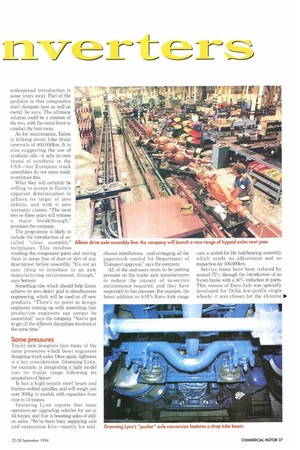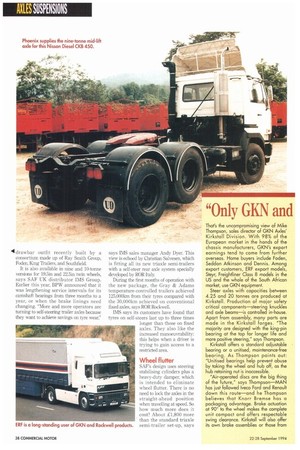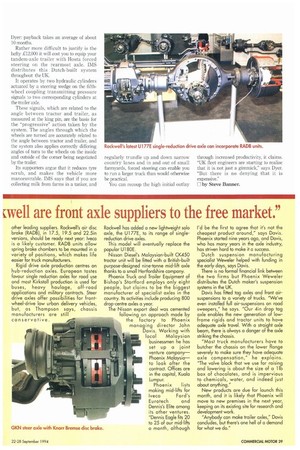Designing a truck drive-axle is a little like playing threedimensional
Page 38

Page 39

Page 40

Page 41

If you've noticed an error in this article please click here to report it so we can fix it.
chess. Truck assemblers—and the operators they supply—want axles which are lighter than their predecessors, so that payload can be increased, but with no loss of strength. Endusers carrying lightweight, highvolume loads want compact axle packages which will help keep the fifth-wheel height as low as possible. Drive axles also have to be able to cope with increased torque from ever more powerful engines, and with operational demands for minimal maintenance—and no-one wants to pay more for them. We've been looking at the products designed to meet these demands... Eaton, which has a major axle plant in Pamplona in Spain, says that this combination of trends has helped prompt the marked swing towards hypoid gears, and away from the spiral bevel type. They take up less space, because the diameter of the gears is reduced. They are also lighter, allow a lower ride height, but do not reduce durability.
Albion Automotive currently makes axles for LDV and Leyland Trucks, and produces some 15,000 sets for light to medium (up to 18 tonnes gross) commercials annually. It will be introducing an all-new range of axles with hypoid gears in about 12 months' time, says chief engineer, Gary Sermon.
"Hypoids have a longer tooth engagement pattern and will accept a higher load— typically 15 to 20% more torque—for the same size of tooth and crown wheel," he says. "The new range will be designed specifically to take 19.5in wheels. There will be no need for anybody to modify the hubs of existing axles."
There's a switch to precision forging in differential gear manufacture, says Eaton. There is no loss of quality or durability, but precision-forged gears are cheaper than cut gears because they don't have to go through so many production processes.
Eaton uses fabricated gear houses, and one of the latest developments involves fabricating them from micro-alloy. "It means you can reduce the thickness of the plate used to manufacture the housing without compromising its strength. Microalloy is light in weight, but very strong," says Eaton.
Special option
Albion's Gary Sermon believes axles will have to be designed to take account of the growing number of operators who want diff-locks fitted. They are no longer an unusual special option, and should not be treated as such. Designers will also have to devote extra thought to more silent running, he predicts: "As engines become quieter and quieter, the axle could become the noisiest part of the vehicle."
Albion is looking at the use of alternative materials composites, fo r example—but Sermon believes that their widespread introduction is some years away. Part of the problem is that composites don't dissipate heat as well as metal, he says. The ultimate solution could be a mixture of the two, with the metal there to conduct the heat away.
As for maintenance, Eaton is talking about lube drain intervals of 400,000km. It is also suggesting the use of synthetic oils—it sells its own brand of synthetic in the USA—but European truck assemblers do not seem ready to embrace this.
What they will certainly be willing to accept is Eaton's apparent determination to achieve its target of zero defects. and with it zero warranty claims. "The next two or three years will witness a major breakthrough," promises the company.
The programme is likely to include the introduction of socalled "clean assembly" Albion drive axle assembly line: the company will launch a new range of hypoid axles next year. techniques. This involves washing the component parts and storing them in areas free of dust or dirt of any description before assembly. "It's not an easy thing to introduce in an axle manufacturing environment, though," says Sermon Something else which should help Eaton achieve its Zero defect goal is simultaneous engineering, which will be used on all new products. "There's no point in design engineers coming up with something that production engineers say cannot be assembled," says the company. "You've got to get all the different disciplines involved at the same time."
Same pressures
Trailer axle designers face many of the same pressures which beset engineers designing truck axles. Once again, lightness is a key consideration. Granning Lynx, for example, is integrating a light model into its trailer range following its acquisition of Spicer.
It has a high-tensile steel beam and friction-welded spindles, and will weigh just over 300kg in models with capacities from nine to 14 tonnes.
Granning Lynx reports that some operators are upgrading vehicles for use at 44 tonnes, and that is boosting sales of addon axles. "We've been busy supplying axle and suspension kits—mostly for mid chassis installationsand arranging all the paperwork needed for Department of Transport approval," says the company.
All of the end-users seem to be putting pressure on the trailer axle manufacturers to reduce the amount of in-service maintenance required, and they have responded to this pressure. For example, the latest addition to SAF's Euro-Axle range uses a sealed-for-life hub/bearing assembly which needs no adjustment and no inspection for 500,000km.
Service times have been reduced by around 75% through the introduction of an S-cam brake with a 90% reduction in parts. This version of Euro-Axle was specially developed for 19.5in low-profile single wheels: it was chosen for the 44-tonne 10 drawbar outfit recently built by a consortium made up of Ray Smith Group, Foden, King Trailers, and Southfield_ It is also available in nine and 10-tonne versions for 19.5in and 22.5in twin wheels, says SAF UK distributor IMS Group. Earlier this year, BPW announced that it was lengthening service intervals for its camshaft bearings from three months to a year, or when the brake linings need changing. "More and more operators are turning to self-steering trailer axles because they want to achieve savings on tyre wear," says IMS sales manager Andy Dyer. This view is echoed by Christian Salvesen, which is fitting all its new triaxle semi-trailers with a self-steer rear axle system specially developed by ROR Italy.
During the first months of operation with the new package, the Gray 8z Adams temperature-controlled trailers achieved 125,000km from their tyres compared with the 30,000km achieved on conventional fixed axles, says ROR Rockwell.
IMS says its customers have found that tyres on self-steers last up to three times longer than those on fixed axles. They also like the increased manoeuvrability: this helps when a driver is trying to gain access to a restricted area.
Wheel flutter SAF's design uses steering stabilising cylinders plus a heavy-duty damper, which is intended to eliminate wheel flutter. There is no need to lock the axles in the straight-ahead position when travelling at speed. So how much more does it cost? About £1,800 more than the standard triaxle ERF is a long-standing user of GKN and Rockwell products, semi-trailer set-up, says
Dyer: payback takes an average of about 10 months.
Rather more difficult to justify is the hefty £12,000 it will cost you to equip your tandem-axle trailer with Hosta forced steering on the rearmost axle. IMS distributes this Dutch-built system throughout the UK.
It operates by two hydraulic cylinders actuated by a steering wedge on the fifthwheel coupling transmitting pressure signals to two corresponding cylinders at the trailer axle.
These signals, which are related to the angle between tractor and trailer, as measured at the king pin, are the basis for the "progressive" action taken by the system. The angles through which the wheels are turned are accurately related to the angle between tractor and trailer, and the system also applies correctly differing angles of turn to the wheels on the inside and outside of the corner being negotiated by the trailer.
Its supporters argue that it reduces tyre scrub, and makes the vehicle more manoeuvrable. DAS says that if you are collecting milk from farms in a tanker, and regularly trundle up and down narrow counfry lanes and in and out of small farmyards, forced steering can enable you to run a larger truck than would otherwise be practical.
You can recoup the high initial outlay through increased productivity, it claims. "UK fleet engineers are starting to realise that it is not just a gimmick," says Dyer. "But there is no denying that it is expensive."
El by Steve Banner.
























































































